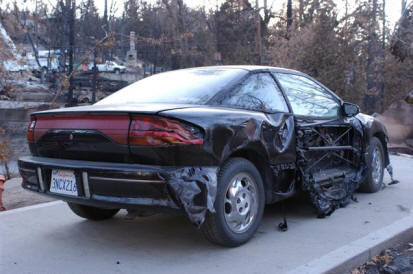|
Planetary Impacts
|
|
| midtskogen | Date: Sunday, 03.03.2013, 08:31 | Message # 1 |
 Star Engineer
Group: Users
 Norway
Norway
Messages: 1674
Status: Offline
| [This thread was split from another thread, and most of the first two pages of posts are out of order]
Quote (HarbingerDawn) I was almost certainly talking about an asteroid/meteoroid between 1 and 10 meters across, which would most certainly never penetrate Earth's atmosphere
An asteriod/meteoriod of that size would very likely produce a large amount of meteorites, but they will be fragments. If it is nearly pure iron (a few % are), much larger pieces or the main lump might reach the ground.
On the other hand, if the asteroid gets very big so that it doesn't slow down to terminal velocity, it will create a huge crater and that impact would disintegrate the original material.
So if it's too small, it will disintegrate, and if it's too big, it will disintegrate as well. The ideal size for finding a significant part in one piece on the ground would be in the meter scale, and it must be iron: if centimeters, it's unlikely that anything will reach the ground, if 100's of meters, it will disintegrate in the ground impact. The are of course other factors as well, like speed and angle. If these other factors are favourable, and it's iron, I would say that your 1-10 meters would be close to the most favourable size as well.
NIL DIFFICILE VOLENTI

Edited by midtskogen - Sunday, 03.03.2013, 08:34 |
| |
| |
| Watsisname | Date: Sunday, 03.03.2013, 08:47 | Message # 2 |
 Galaxy Architect
Group: Global Moderators
 United States
United States
Messages: 2613
Status: Offline
| Mmm, seems we have an a scientific debate. On the subject of the effects of large impacts on the Martian atmosphere, I concur with HarbingerDawn. And Martek, I'd like to respond to a few of your points and questions.
Quote (Martek) Actually, yes it can. It can thicken the atmosphere enough and kick up a lot of vapor to change the climate on Mars forever. It could very well do that and there is evidence that suggests that it can thicken Martian atmosphere and after the dust settles the planet may warm itself up.
Can you link to examples of this evidence, or relevant journal articles?
Quote (Martek) There is always a chance for anything. have you witnessed a comet that size smashing into Mars? No? Okay then. So an appropriate answer would be to reserve possibility it could happen.
Possibilities for what may happen are limited by the laws of physics. And although we have not observed a comet impacting Mars, we can use physics to determine what the results would be. We can also examine what the effects of large impacts in the past were. The overarching theme of such studies is that on Mars, large impacts actually eject a significant portion of the atmosphere. If you care to read into some of these studies, here's a good one that is free to view.
Quote (Martek) If you want to talk about stripping away an atmosphere then you could explain to me why Earth still has an atmosphere after the large meteor impact occurred that wiped out the dinosaurs?
I think the answer to your question isn't too difficult to figure out -- try giving it some thought and examine the differences between the two scenarios.
If you still have doubts, check this figure, which comes from the paper I linked above:
Quote (Martek) If you want to get technical, Mars acquired its thin atmosphere because of the very weak Magnetism it has. Unlike Earth, Mars is not safe from the Sun's radiation and the components in the atmosphere are hurled into space.
This is an extremely common belief, but it is actually incorrect. See my post in the Exoplanet News Thread. 
Quote (Martek) Lastly, another theory is that the Universe is Expanding... true? Yes, very true. So is it the continents spreading apart or is it actually the Earth expanding and separating the land masses? Like I said, anything is possible.
This isn't a theory, it is a fact which can be seen from simple observations.
And no, the expansion of the universe has absolutely nothing to do with plate tectonics. (See my post in the How Big is the Universe thread. The Earth is not expanding, either.
Quote (Martek) "a comet strike on Mars could jumpstart terraforming efforts by delivering a big load of volatiles (water, methane, CO2 and so on), plus a lot of heat energy that could release water and other volatiles from the martian soil."
Mars' atmosphere evolved to its current state about 3.8 billion years ago. Since then there have been multiple impacts of the sort we are discussing here. Why, then, has Mars not been visibly terraformed by those impacts?
edit: added figure

Edited by Watsisname - Sunday, 03.03.2013, 09:03 |
| |
| |
| HarbingerDawn | Date: Sunday, 03.03.2013, 08:57 | Message # 3 |
 Cosmic Curator
Group: Administrators
 United States
United States
Messages: 8717
Status: Offline
| Quote (midtskogen) An asteriod/meteoriod of that size would very likely produce a large amount of meteorites, but they will be fragments.
Yes. I didn't mean that none of it would penetrate, just that it would not penetrate intact; i.e. that it would disintegrate above the surface.
And as you said, there could be exceptions for pure iron meteoroids, but these are very rare.
All forum users, please read this!
My SE mods and addons
Phenom II X6 1090T 3.2 GHz, 16 GB DDR3 RAM, GTX 970 3584 MB VRAM
|
| |
| |
| midtskogen | Date: Sunday, 03.03.2013, 10:40 | Message # 4 |
 Star Engineer
Group: Users
 Norway
Norway
Messages: 1674
Status: Offline
| Quote (HarbingerDawn) Yes. I didn't mean that none of it would penetrate, just that it would not penetrate intact; i.e. that it would disintegrate above the surface.
I think it's safe to say that nothing will penetrate intact, no matter the size, composition, speed, etc.
NIL DIFFICILE VOLENTI

|
| |
| |
| HarbingerDawn | Date: Sunday, 03.03.2013, 11:38 | Message # 5 |
 Cosmic Curator
Group: Administrators
 United States
United States
Messages: 8717
Status: Offline
| Quote (midtskogen) I think it's safe to say that nothing will penetrate intact, no matter the size, composition, speed, etc.
Of course it will... there are plenty of size/composition/speed combinations that can allow for intact atmospheric passage. If that wasn't true then none of our astronauts would have ever made it back to Earth alive. A sufficiently large or dense or slow object could survive, and this has happened many times in the history of our planet. And when I say intact, I don't mean 0 mass loss during atmospheric passage, I mean insignificant mass loss.
All forum users, please read this!
My SE mods and addons
Phenom II X6 1090T 3.2 GHz, 16 GB DDR3 RAM, GTX 970 3584 MB VRAM
|
| |
| |
| midtskogen | Date: Sunday, 03.03.2013, 19:06 | Message # 6 |
 Star Engineer
Group: Users
 Norway
Norway
Messages: 1674
Status: Offline
| Quote (HarbingerDawn) Of course it will... there are plenty of size/composition/speed combinations that can allow for intact atmospheric passage. If that wasn't true then none of our astronauts would have ever made it back to Earth alive.
No. The context here was meteoroids/asteroids. First, none of these have heat shields, parachutes, engines or whatever that could bring down a spacecraft safely. Secondly, astronauts usually reenter Earth's atmosphere at orbit speed, which is lower than the lowest speed a meteoroid/asteroid possibly can have relative to earth, 11 km/s.
Quote (HarbingerDawn) A sufficiently large or dense or slow object could survive, and this has happened many times in the history of our planet.
Sufficiently slow, yes, but the object has to obey the laws of gravity, so it can't go below 11 km/t. Can you give any examples from the history of our planet?
Quote (HarbingerDawn) And when I say intact, I don't mean 0 mass loss during atmospheric passage, I mean insignificant mass loss.
If you look at meteorites, even dense ones, you can clearly tell from their surfaces that they have had a brutal encounter with our atmosphere. Even if the mass loss was insignificant (which I still believe unlikely, but I don't deny the possibility that more than half of the object can survive is a single piece), I would hardly call it intact.
If I lend you my car and you return it like this:

then I would hardly call it intact even though the mass loss is insignificant. Get my point?  And I car wouldn't look as good as this if it entered the atmosphere at 11 km/s... And I car wouldn't look as good as this if it entered the atmosphere at 11 km/s...
NIL DIFFICILE VOLENTI

|
| |
| |
| HarbingerDawn | Date: Sunday, 03.03.2013, 20:17 | Message # 7 |
 Cosmic Curator
Group: Administrators
 United States
United States
Messages: 8717
Status: Offline
| Quote (midtskogen) If I lend you my car and you return it like this then I would hardly call it intact
Ok, but I clearly defined "intact" the way I was using it, so that would be intact. It doesn't matter what you call it. By your definition of "intact" even the Apollo spacecraft didn't make it back to Earth intact. Yet that's an absurd thing to say since by all reasonable criteria it did.
Quote (midtskogen) Sufficiently slow, yes, but the object has to obey the laws of gravity, so it can't go below 11 km/t
There are also objects (artificial, of course) that have survived higher speeds. I'll get to why this is relevant: you strongly implied in your earliest post on this page that a large object would survive mostly intact through the atmosphere and disintegrate on impact, and also implied that a lump of iron of a certain size would survive intact through both atmosphere and impact. Please clarify if I misunderstood. Then you turn around and say that "nothing will penetrate intact, no matter the size, composition, speed, etc." So either I seriously misunderstood what you were saying somewhere, or you contradicted yourself.
Quote (midtskogen) And I car wouldn't look as good as this if it entered the atmosphere at 11 km/s...
And as you clearly stated, we're not talking about cars here...
Quote (midtskogen) Can you give any examples from the history of our planet?
Craters and the objects that made many if not most of them.
Quote (midtskogen) If you look at meteorites, even dense ones, you can clearly tell from their surfaces that they have had a brutal encounter with our atmosphere. Even if the mass loss was insignificant (which I still believe unlikely, but I don't deny the possibility that more than half of the object can survive is a single piece), I would hardly call it intact.
But what size would be the largest meteorite we've ever examined (as in size of original object)? Have we ever examined the remains of an object 1 km wide? 10 km wide? 50 km wide? And if so, have we conclusively determined what kind of damage was sustained in the atmosphere vs on impact? When calling on evidence from known meteorites, does that really represent a sufficient sample size to make broad generalizations from?
All forum users, please read this!
My SE mods and addons
Phenom II X6 1090T 3.2 GHz, 16 GB DDR3 RAM, GTX 970 3584 MB VRAM
Edited by HarbingerDawn - Sunday, 03.03.2013, 20:19 |
| |
| |
| Watsisname | Date: Sunday, 03.03.2013, 23:23 | Message # 8 |
 Galaxy Architect
Group: Global Moderators
 United States
United States
Messages: 2613
Status: Offline
| Quote (midtskogen) Yeah, you'll be totally intact if you fall off a cliff, but not after the landing...
I think it is exceedingly obvious that we are discussing the atmospheric passage, not what happens if/when it actually hits the ground.
Quote (HarbingerDawn)
That is exactly what I have been trying to say this whole time!
Indeed. I was just trying to reinforce it. 

|
| |
| |
| HarbingerDawn | Date: Monday, 04.03.2013, 05:29 | Message # 9 |
 Cosmic Curator
Group: Administrators
 United States
United States
Messages: 8717
Status: Offline
| Quote (Watsisname) Indeed. I was just trying to reinforce it.
I know, I meant my statement as an exclamation of ecstasy and relief that I could point to someone else summing up the same point I was making in a more clear way 
All forum users, please read this!
My SE mods and addons
Phenom II X6 1090T 3.2 GHz, 16 GB DDR3 RAM, GTX 970 3584 MB VRAM
Edited by HarbingerDawn - Monday, 04.03.2013, 05:44 |
| |
| |
| midtskogen | Date: Monday, 04.03.2013, 07:02 | Message # 10 |
 Star Engineer
Group: Users
 Norway
Norway
Messages: 1674
Status: Offline
| We're obviously talking a bit past each other here. I'm talking about objects (manmade or not) falling uncontrolled (as a meteor) to the ground, including impact (otherwise it's pretty meaningless like the statement that it's not the fall that kills you). Even meteors too big to disintegrate before impact, will be explosions in progress, they just haven't had the time to finish at impact. If the Earth somehow got replaced with vacuum and the atmosphere stayed as a shell, I think you would need a very big object not to break up at all having gone through the atmosphere. But this is getting very hypothetical. But if course, if big enough it would only dent its surface. And if there were any very big object that could hit us as slow as 11 km/s, I think we would know about it (or they all hit us a long time ago).
NIL DIFFICILE VOLENTI

|
| |
| |
| HarbingerDawn | Date: Monday, 04.03.2013, 07:35 | Message # 11 |
 Cosmic Curator
Group: Administrators
 United States
United States
Messages: 8717
Status: Offline
| Quote (midtskogen) We're obviously talking a bit past each other here.
midtskogen, no offense, but you're the one who is doing all of the misunderstanding here. I was extremely clear that I was referring only to the passage of objects through the atmosphere, with impact on the surface being irrelevant. I said this at multiple times in multiple ways. Watsisname understood me perfectly. So the confusion is only with you. I don't know why you insist on looking at words through one and only one definition (like when we were having the "terra" discussion), and why you are looking at these situations only as whole events, unable to analyze them in parts.
We're interested in what happens specifically during atmospheric passage because that will determine the exact nature of the surface impact. It is something that is worth discussing on its own, and the surface impact itself need never enter into the conversation.
All forum users, please read this!
My SE mods and addons
Phenom II X6 1090T 3.2 GHz, 16 GB DDR3 RAM, GTX 970 3584 MB VRAM
|
| |
| |
| Watsisname | Date: Monday, 04.03.2013, 08:14 | Message # 12 |
 Galaxy Architect
Group: Global Moderators
 United States
United States
Messages: 2613
Status: Offline
| I believe everything we've covered is worthy of continued discussion as long as we can understand both the definitions and the themes that the other people are following. 
Quote (midtskogen) Even meteors too big to disintegrate before impact, will be explosions in progress, they just haven't had the time to finish at impact. If the Earth somehow got replaced with vacuum and the atmosphere stayed as a shell, I think you would need a very big object not to break up at all having gone through the atmosphere. But this is getting very hypothetical.
I wouldn't say it's all that hypothetical... this is actually a fairly well-studied subject. Try playing through the applet I linked earlier. They also have a pdf page which describes the equations they used and the physics involved, though the physics is very simplified for the sake of computational feasibility. It is also an excellent literature review with many references to more detailed studies of the processes involved. I'm currently reading through this one, it's quite good.

|
| |
| |
| midtskogen | Date: Monday, 04.03.2013, 09:11 | Message # 13 |
 Star Engineer
Group: Users
 Norway
Norway
Messages: 1674
Status: Offline
| Quote (Watsisname) I wouldn't say it's all that hypothetical
Hypthetical in the sense that it's an even more stretch of the term "intact" if the object, though still in one piece technically, already before impact has seismic waves inside which will surely rip it apart if it wasn't for the impact, but it hasn't been time for it simply because such waves travel slower than the impact speed, and surely there will be "superseismic" effects as well, such as from the (vaporised) front of the impactor travelling slower than the rear part. So if the Earth's atmosphere were a shell around a vacuum, it would pass through the shell in one piece but disintegrate inside it in that case.
To have something reaching the ground "intact" (in the sense melted crust, lost some weight but not seriously fragmented), excluding the totally unrealistic like pure iron Vesta sized objects, I think we must look for relatively small and dense objects, something similar to Harb's original statement about a 1-10 meter object "that would most certainly never penetrate Earth's atmosphere", which I thought was worth a comment, since that size, if other parameters are favourable, is roughly within the sweet spot what size goes for "intact" impacts. But, of course, in the normal case, a 1-10 meter object would break up. I hope that this clarification brings the discussion back on track. The point is (for realistic objects), too small: disintegration. Too big: disintegration. 1-10 meters: perhaps not (though I don't think we can define rigid boundaries).
The impact program seems to agree on that, but it seems to miss one possible outcome totally, that the object simply bounces off Earth's atmosphere if the angle is very low. The program will have any object reach the ground intact no matter the size if the angle is small enough. In reality the object would go into space again.
Edit: The program doesn't make sense for objects on a centimeter scale either. It's easy to have it produce meteorites hitting the ground at feather speed creating small craters. 
NIL DIFFICILE VOLENTI

Edited by midtskogen - Monday, 04.03.2013, 09:48 |
| |
| |
| Watsisname | Date: Monday, 04.03.2013, 10:35 | Message # 14 |
 Galaxy Architect
Group: Global Moderators
 United States
United States
Messages: 2613
Status: Offline
| Quote (midtskogen) Hypthetical in the sense that it's an even more stretch of the term "intact" if the object, though still in one piece technically, already before impact has seismic waves inside which will surely rip it apart if it wasn't for the impact, but it hasn't been time for it simply because such waves travel slower than the impact speed, and surely there will be "superseismic" effects as well, such as from the (vaporised) front of the impactor travelling slower than the rear part.
[etc]
Your understanding of the physics of meteor fragmentation is incorrect.
Meteors do not breakup because of seismic waves traveling through them. They break up if the differential pressure over their surface is greater than their material strength, which leads to fracturing. This process is ineffective for impactors whose mass is much greater than the mass of atmosphere they displace during entry. In your hypothetical example of an object passing through a shell of atmosphere, it would be mostly unaffected by said passage if it was several kilometers across.
Also, if the object is as you say 'in one piece technically' then that's all we originally cared about. We did not care if it would have fragmented anyway if the ground wasn't there.
Quote (midtskogen) The impact program seems to agree on that, but it seems to miss one possible outcome totally, that the object simply bounces off Earth's atmosphere if the angle is very low. The program will have any object reach the ground intact no matter the size if the angle is small enough. In reality the object would go into space again.
Quote (watsisname) They also have a pdf page which describes the equations they used and the physics involved, though the physics is very simplified for the sake of computational feasibility.
The pdf page specifically says that Earth is modeled as a plane, not a curve. So it is impossible in the program for an object to 'bounce' off the atmosphere. The applet is not designed to perfectly model all possible scenarios, but instead give a rough overview of typical ones. More careful treatments of meteor and impact phenomenon are given by the other studies it cites.
edit: May I suggest a thread split? This discussion seems sufficiently lengthy and tangential to warrant its own thread I think.

Edited by Watsisname - Monday, 04.03.2013, 10:55 |
| |
| |
| midtskogen | Date: Monday, 04.03.2013, 11:06 | Message # 15 |
 Star Engineer
Group: Users
 Norway
Norway
Messages: 1674
Status: Offline
| Quote (Watsisname)
Your understanding of the physics of meteor fragmentation is incorrect.
Meteors do not breakup because of seismic waves traveling through them.
I didn't precisely describe it in such a way.
Quote (Watsisname) They break up if the differential pressure over their surface is greater than their material strength, which leads to fracturing.
Whose effects some way or another will propagate into its interior, and it isn't a happening at light speed. So there exists a state for the interior where fracturing has not yet happened but is inevitable because of the pressure over the surface.
NIL DIFFICILE VOLENTI

|
| |
| |